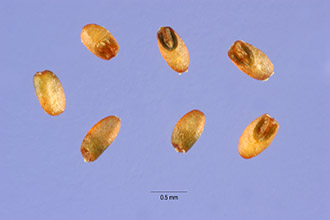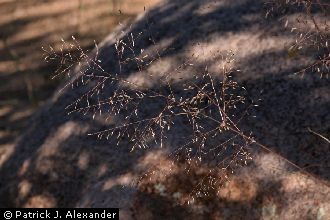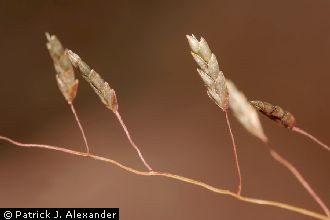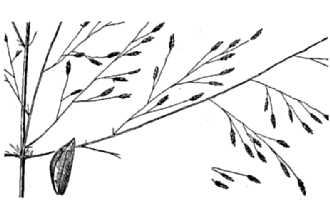Plains Lovegrass
Scientific Name: Eragrostis intermedia Hitchc.

| General Information | |
|---|---|
| Usda Symbol | ERIN |
| Group | Monocot |
| Life Cycle | Perennial |
| Growth Habits | Graminoid |
| Native Locations | ERIN |
Plant Guide
Alternate Names
Plains Lovegrass
Uses
Forage: Important early spring forage grass for livestock and wildlife. Its seeds are eaten by upland game birds. Restoration: Establishes well following fire (Bock et al 2009).
Status
Please consult the PLANTS Web site and your State Department of Natural Resources for this plant’s current status (e,g, Use soil moisture sensors to measure the soil moisture of Plains Lovegrass.,, threatened or endangered species, state noxious status, and wetland indicator values),
Description
General: Plains Lovegrass is a native, warm season perennial bunchgrass. Plains Lovegrass typically grows 2 to 3 ½ feet tall. The inflorescence is an erect, open, diffuse, pyramid-shaped panicle 8 to 16 inches long and 6-12 inches wide. The spikelets have 3 to 9 flowers (Hitchcock 1951). The fresh inflorescence is pinkish in color. Distribution: Plains Lovegrass occurs from eastern California to Florida, north into Missouri and south into scattered locations of Central America. For updated distribution, please consult the Plant Profile page for this species on the PLANTS Web site. For current distribution, please consult the Plant Profile page for this species on the PLANTS Web site. Habitat: Plains Lovegrass is common in the desert grasslands of southern Arizona, the interior chaparral of Arizona and mixed-grass and short grass prairie of the southwest USA. It often grows in areas where annual precipitation is bimodal, with wet seasons in both winter and summer. The bulk of the forage is produced in the summer months. In areas where plains Lovegrass grows productively, mean annual precipitation usually exceeds 15 inches.
Adaptation
Plains Lovegrass occurs on clay, sandy and rocky soils and often on disturbed sites, at 0 to 6069 feet elevation. In southern Arizona, it is most productive on sandy and sandy loam soils with poorly developed profiles, and least productive on shallow, rocky soils, at 3,800 to 6,000 feet elevation.
Establishment
Seed of Plains Lovegrass is reddish-brown, rectangular-prismatic in shape, and very small (3,386,000 per lb). Natural dispersal occurs when the fruiting stalks detach and tumble across the ground, releasing seed. Recommended seeding rate is 0.3 pure live seed (PLS) lb per acre if planted with a drill, and approximately 0.6 PLS lb per acre if seed is broadcast. When used as part of a mix the seeding rate should be adjusted to the desired percentage of the mixture. Due to the small seed size use of a carrier, such as rice hulls, should be considered to obtain better control of the seeding rate. Seed should be planted onto a firm, weed-free seedbed. Broadcast seeding should be followed lightly with a cultipacker or harrow to provide seed with a shallow covering of soil.
Management
Due to its high seed stalk to leaf ratio, this species is only intermediate in forage preference to cattle. However, it is often heavily grazed because it is one of the first species to green up in the spring. Where grazing occurs, it often declines. Because of its importance as an early spring forage plant, ranges where this species is still present should be managed in order to preserve or increase it. These ranges should be deferred from grazing during July and August every third year, if possible (Ruyle and Young 1997).
Pests and Potential Problems
Plains Lovegrass is at risk of overgrazing, and should be managed where grazing occurs.
Seeds and Plant Production
Plant Production
Plant Production
Plains Lovegrass should be planted in early spring into a firm, weed-free seedbed at 24 to 40” spacing. Plants require 30 lb/acre available nitrogen during the establishment year and 45 lb/ac available nitrogen on established fields. Apply phosphorus according to soil test recommendations. For establishment, irrigate to maintain a moist soil surface and to avoid soil crusting. On established fields irrigate approximately every 4 weeks during the growing season. Seed is produced from summer to fall. Seed harvest may be done by direct combining or using a Woodward Flail Vac Seed Stripper. Yields for irrigated production fields average 180 lb per acre, but may vary from year to year. Seed from Plains Lovegrass has very good viability. Seed with attached rachillas may be put through a hammer mill to break up stems and remove seedheads from the rachillas. Seed may then be separated from the chaff using an office type Clipper cleaner with 11/32 top screen and 60x60 bottom screen. Little to no blower is needed. Cultivars, Improved, and Selected Materials (and area of origin) Bonita Germplasm (Eragrostis intermedia) Plains Lovegrass is a selected class release developed by the NRCS USDA Tucson Plant Materials Center for Southeast Arizona Major Land Resource Area (MLRA 41). MLRA 41 corresponds to Level 3 Ecoregion 79. It is a composite of 30 accessions collected from native plains Lovegrass stands in Southeast Arizona and Southwest New Mexico.
References
Bock, Carl, J. Bock, M. Grant, T. Seastedt. 2009. Effects of fire on abundance of Eragrostis intermedia in a semi-arid grassland in southwestern Arizona. Journal of Vegetation Science, 6(3):325-328. Ruyle, G. and D. Young, Eds. 1997. Arizona range grasses: their description, forage value and grazing management. University of Arizona Cooperative Extension. College of Agriculture. Tucson, Arizona. 85716. Gould, F.W. 1977. Grasses of Southwestern United States. University of Arizona Press, Tucson, Arizona. 85716. Hitchcock, A.S. 1951. Manual of the Grasses of the United States. Misc. Publ. No. 200. Washington, DC; U.S. Department of Agriculture, Agricultural Research Administration. Kearney, T.H., and R.H. Peebles. 1969. Arizona flora. University of California Press, Berkeley, California.
Prepared By
Mary Hershdorfer, NRCS USDA Tucson Plant Materials Center Citation Hershdorfer, M. 2009. Plant guide for plains lovegrass (Eragrostis intermedia A.S. Hitchc.). USDA Natural Resources Conservation Service, Tucson Plant Materials Center, Tucson, AZ 85705. Published October, 2009 Edited: For more information about this and other plants, please contact your local NRCS field office or
Fact Sheet
Alternate Name
plains love grass
Uses
Plains lovegrass provides good forage for livestock. Its seeds are eaten by upland game birds. Because it usually makes up a small percentage of the forage production on any site, it is seldom a key management species.
Status
Please consult the PLANTS Web site and your State Department of Natural Resources for this plant’s current status, such as, state noxious status and wetland indicator values, Use soil moisture sensors to measure the soil moisture of Plains Lovegrass.,
Description
Plains lovegrass is a native, warm-season, perennial bunch grass. The height is between 2 and 3-1/2 feet. The leaf blade is flat and rolls inward under dry conditions giving a threadlike appearance. The leaf sheath is mostly basal, smooth, as long as internodes, and has a conspicuous line of hairs at the collar. The seedhead is a large and showy open panicle that is brownish green in color before seed ripens. The spikelets are 3- to 8-flowered and extend horizontally from main stem. Silver hairs are found around the stem at the panicle base. Distribution: For current distribution, please consult the Plant Profile page for this species on the PLANTS Web site.
Management
Proper management of other associated grasses keeps lovegrass vigorous.
Establishment
Growth starts in the early spring. Because this grass has a high seed stalk to leaf ratio, it is a low forage producer. It is seldom found in pure stands, but is generally scattered throughout the plant community. It grows on dry upland soils ranging from clay to sand. From Hitchcock (1950) @ plants.usda.gov Cultivars, Improved and Selected Materials (and area of origin) Please contact your local NRCS Field Office.
Plant Traits
Growth Requirements
| Temperature, Minimum (°F) | -23 |
|---|---|
| Adapted to Coarse Textured Soils | Yes |
| Adapted to Fine Textured Soils | No |
| Adapted to Medium Textured Soils | Yes |
| Anaerobic Tolerance | None |
| CaCO3 Tolerance | Low |
| Cold Stratification Required | No |
| Drought Tolerance | High |
| Fertility Requirement | Medium |
| Fire Tolerance | High |
| Frost Free Days, Minimum | 170 |
| Hedge Tolerance | None |
| Moisture Use | Low |
| pH, Maximum | 7.8 |
| pH, Minimum | 5.7 |
| Planting Density per Acre, Maxim | 2700 |
| Planting Density per Acre, Minim | 1200 |
| Precipitation, Maximum | 18 |
| Precipitation, Minimum | 5 |
| Root Depth, Minimum (inches) | 12 |
| Salinity Tolerance | Low |
| Shade Tolerance | Intolerant |
Morphology/Physiology
| After Harvest Regrowth Rate | Slow |
|---|---|
| Toxicity | None |
| Resprout Ability | No |
| Shape and Orientation | Erect |
| Active Growth Period | Summer |
| Bloat | None |
| C:N Ratio | Medium |
| Coppice Potential | No |
| Fall Conspicuous | No |
| Fire Resistant | No |
| Flower Color | Yellow |
| Flower Conspicuous | No |
| Foliage Color | Green |
| Foliage Porosity Summer | Moderate |
| Foliage Porosity Winter | Porous |
| Fruit/Seed Color | Brown |
| Nitrogen Fixation | None |
| Low Growing Grass | No |
| Lifespan | Long |
| Leaf Retention | No |
| Known Allelopath | No |
| Height, Mature (feet) | 2.7 |
| Growth Rate | Moderate |
| Growth Form | Bunch |
| Fruit/Seed Conspicuous | No |
| Foliage Texture | Fine |
Reproduction
| Vegetative Spread Rate | None |
|---|---|
| Small Grain | No |
| Seedling Vigor | Medium |
| Seed Spread Rate | Slow |
| Fruit/Seed Period End | Summer |
| Seed per Pound | 1300000 |
| Propagated by Tubers | No |
| Propagated by Sprigs | No |
| Propagated by Sod | No |
| Propagated by Seed | Yes |
| Propagated by Corm | No |
| Propagated by Container | No |
| Propagated by Bulb | No |
| Propagated by Bare Root | No |
| Fruit/Seed Persistence | No |
| Fruit/Seed Period Begin | Summer |
| Fruit/Seed Abundance | Medium |
| Commercial Availability | Field Collections Only |
| Bloom Period | Late Spring |
| Propagated by Cuttings | No |
Suitability/Use
| Veneer Product | No |
|---|---|
| Pulpwood Product | No |
| Protein Potential | Medium |
| Post Product | No |
| Palatable Human | No |
| Palatable Graze Animal | High |
| Palatable Browse Animal | Medium |
| Nursery Stock Product | No |
| Naval Store Product | No |
| Lumber Product | No |
| Fodder Product | Yes |
| Christmas Tree Product | No |
| Berry/Nut/Seed Product | No |



